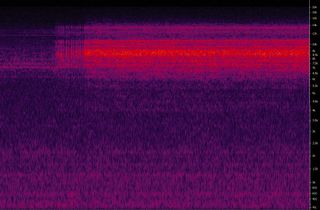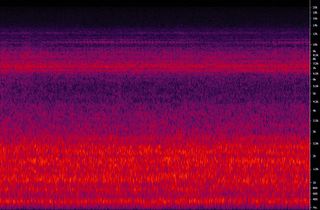AMD Radeon HD 7990: Eight Games And A Beastly Card For $1,000
We've been waiting for this since 2011. AMD is ready to unveil its Radeon HD 7990, featuring a pair of Tahiti graphics processors. Can the dual-slot board capture our hearts with great compute and 3D performance, or does Nvidia walk away with this round?
Noise Analysis: Frequency Spectrum And Videos
Let’s start with a task that features a continually-changing load, never reaching 100% or falling below 40%. We begin our video analysis with a round of Crysis 3. You’ll hear the card start whining at the five-second mark.
Since the fans start off quietly and only become audible toward the end of our video, we want to concentrate on the parasitic noise that dominates throughout the recording. The fans aren’t responsible for this card’s noise levels at all. A frequency spectrogram helps us to understand this better. Its color scale represents the individual levels ranging from blue (quiet) and purple (middle) through red (elevated noise levels) to orange and yellow (loud). Green stands for the predetermined upper limit, which is never reached:

The fans only kick into high gear when a compute-heavy app pushes both Tahiti GPUs to full load, filling in the lower end of the frequency spectrum. This makes them seem louder to human ears, as if they were responsible for the overall noise level. A video helps us illustrate once again.
And here’s the spectrogram that goes along with the video. It shows us how the fans easily drown out the whining under full load.

We’ve learned two things. First, as a result of the components generating noise at different frequencies, AMD’s Radeon HD 7990 cannot be accurately measured using a simple sound level meter. Second, AMD partly undermines the hard-earned progress that went into quieting its cooling solution. Although the overall result isn’t bad (we’re certainly much happier with the 7990 than the 6990), the high-pitched whine is noticeable enough to illicit raised eyebrows from observers correctly ascertaining that a graphics card shouldn’t be making those noises.
Reference Under Load: GeForce GTX 690
To give you a point of comparison, we applied the same load to GeForce GTX 690 and recorded its output.
Stay on the Cutting Edge
Join the experts who read Tom's Hardware for the inside track on enthusiast PC tech news — and have for over 25 years. We'll send breaking news and in-depth reviews of CPUs, GPUs, AI, maker hardware and more straight to your inbox.
Current page: Noise Analysis: Frequency Spectrum And Videos
Prev Page Noise Measurements And Fan Speed Next Page OpenCL: General-Purpose Computing-
blackmagnum If I had 1,000 dollars... I would buy a Titan. Its power efficiency, drivers and uber-chip goodness is unmatched.Reply -
timw03878 Here's an idea. Take away the 8 games at 40 bucks a piece and deduct that from the insane 1000 price tag.Reply -
donquad2001 this test was 99% useless to the average gamer,Test the card at 1900x1080 like most of us use to get a real ideal of what its like,only your unigine benchmarks helped the average gamer,who cares what any card can do at a resolution we cant use anyway?Reply -
cangelini whysoPower usage?Thats some nice gains from the prototype driver.Power is the one thing I didn't have time for. We already know the 7990 is a 375 W card, while GTX 690 is a 300 W card, though. We also know AMD has Zero Core, which is going to shave off power at idle with one GPU shut off. I'm not expecting any surprises on power that those specs and technologies don't already insinuate.Reply -
cangelini donquad2001this test was 99% useless to the average gamer,Test the card at 1900x1080 like most of us use to get a real ideal of what its like,only your unigine benchmarks helped the average gamer,who cares what any card can do at a resolution we cant use anyway?If you're looking to game at 1920x1080, I can save you a ton of money by recommending something less than half as expensive. This card is for folks playing at 2560 *at least.* Next time, I'm looking to get FCAT running on a 7680x1440 array ;)Reply -
hero1 Nice article. I was hopping that they would have addressed the whining but they haven't and that's a shame. Performance wise it can be matched by GTX 680 SLI and GTX 690 without the huge time variance and runt frames. Let's hope they fix their whining issue and FPS without forcing users to turn on V-sync. For now I know where my money is going consider that I have dealt with AMD before:XFX and Sapphire and didn't like the results (whining, artifacts, XF stops working etc). Sorry but I gave the red team a try and I will stick with Nvidia until AMD can prove that they have fixed their issues.Reply
Most Popular

